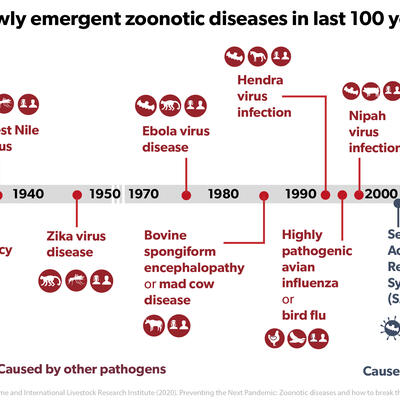
Pills for the pandemic: Dieter Schillinger gives an update on pharmaceuticals for treating COVID-19
In a presentation titled ‘Pills for the Pandemic’ for the International Livestock Research Institute’s in-house townhall on 26 November 2021, Dieter Schillinger, deputy director general of research and development–Animal and Human Health, gave an update on pharmaceuticals for treating COVID-19. There are currently two new antiviral COVID-19 treatments that can be administered in pill form: Merck’s molnupiravir, which has obtained emergency use authorization (EUA) in the United Kingdom and the US, and Pfizer’s Paxlovid™, which has been submitted to the U.S. Food and Drug Administration (FDA) for emergency use authorization.
The benefits of an antiviral COVID-19 treatment in pill form are twofold: 1) people can treat themselves at home, and 2) these pharmaceuticals are relatively cheap to manufacture. The United States has already purchased millions of doses. Previously, monoclonal antibodies, which mimic the natural antibodies needed to fight the virus, were the only antivirals that could be used to treat COVID-19. These antivirals were recommended for early treatment in high-risk unvaccinated people and have been shown to reduce severe illness when given within five to seven days of symptom onset. However, as Schillinger explained, they need to be administered intravenously and are very expensive. This is where molnupiravir and Paxlovid come in.
Molnupiravir is the first novel antiviral COVID-19 treatment in oral form, said Schillinger. It reduced the risk of death or hospitalization by 50 per cent in non-hospitalized adults with mild to moderate cases of infection when treated within five days onset of symptoms. (However, Merck recently reported that that number has fallen to 30 per cent.)
Paxlovid has been shown to be highly effective. The risk of hospitalization or death was reduced by 89 per cent when patients were treated within three days of symptom onset. However, the effectiveness was reduced, Schillinger said, the longer before treatment.
The critical question, said Schillinger, is about access: There are efforts underway to ensure equitable access to both molnupiravir and Paxlovid—through a tiered pricing approach, advance purchase agreements with multiple countries and investments to support manufacturing and distribution. But the challenge is that there is a minimal window of opportunity for the treatment to be effective, and that window negatively impacts individuals living in developing countries, particularly in rural areas. If a patient loses just one day between the symptom onset and the start of treatment—for example, because of limited testing opportunities—they can potentially miss out on the five-day window for the product to work—a major problem for developing countries.
‘These two treatments won’t close the COVID-19 book, but they will be valuable additions to what we have’, said Schillinger. ‘Unfortunately, they probably won’t be immediately available in low and middle-income countries’, he added. 'What we need is more antiviral pills, virus-fighting antibodies engineered to stick around in people's bodies, and fast turn-around testing and regulatory processes.' He concluded by emphasizing the continuing importance of nonpharmaceutical interventions. ‘Masks, distancing, everything that we have been advised thus far are still essential. What is clear is that prevention is better than cure. And prevention is definitely cheaper than cure.’


















